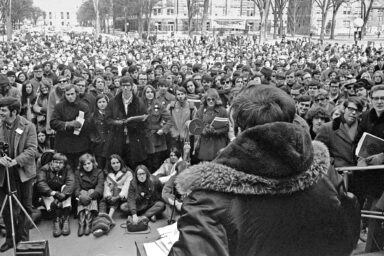How the trade war, corporate tax cuts, and fossil fuel subsidies have hurt many small businesses.
Donald Trump ran for president as a billionaire businessman claiming to have exceptional negotiating skills and promising to reduce the US trade deficit. How’s it working out?
Jim Doyle is president of the Business Forward Foundation in Washington, DC, representing about 100,000 small business owners in America. Talking about a new report, “Answering America: The Business Case Against Trump’s Agenda,” Doyle argues that Trump’s policies aren’t good for the economy, business, or the American worker.
In this conversation, we focus on the trade wars, particularly with China, and cite fresh data from Public Citizen showing that US trade deficits are going up, not down. While Trump has promised to revive the coal industry, it continues to decline despite federal subsidies that amount to about $70,000 per worker; Doyle says that for every remaining coal job, there are 16 jobs in the renewable energy sectors.
You can read the report and get more information on the Business Forward Foundation here.
Click HERE to Download Mp3
Full Text Transcript:
As a service to our readers, we provide transcripts with our podcasts. We try to ensure that these transcripts do not include errors. However, due to time constraints, we are not always able to proofread them as closely as we would like. Should you spot any errors, we’d be grateful if you would notify us.
| Peter B. Collins: | Welcome to another radio WhoWhatWhy Podcast in San Francisco. I’m Peter B. Collins.
Donald Trump campaigned as this billionaire expert on business, particularly on trade policy. So how’s it going, three years in for American workers and for American businesses? Jim Doyle joins us today from the Business Forward Foundation based in Washington DC. Jim served in the Bill Clinton administration back in the 90s. And Jim, tell us a little bit about Business Forward. What kind of a foundation and operation is this? |
| Jim Doyle: | Business Forward helps local business leaders around the country, brief mayors, governors, congress, the administration, and the men and women who are running for president on issues that affect their business, like trade, infrastructure, tax policy, healthcare. It’s a way for business leaders who care about the issues but have a business to run, to get involved in a meaningful and efficient way. So you can attend a briefing and tell a candidate for president what you think about infrastructure. We’ll help you write out bids, we’ll help you organize other business leaders in your community, help you submit testimony of government hearings, whatever you want to do and whichever issue where you want to help, we’ll help you do it. |
| Peter B. Collins: | So if we had a little spectrum here of think tanks in Washington, would you be closer to the Center for American Progress than say the American Enterprise Institute or CATO? |
| Jim Doyle: | So we’d be in the middle, center left. We work with business leaders across the country, a hundred thousand. We’ve got a couple of hundred in nearly every congressional district. 6 out of 10 are women, 1 out of 4 live in a rural area, about 1 out of 3 own their own small business, or they’re a senior executive at a midsize company. It’s generally a centrist organization but with a real bias, and the bias is to get things done. These are people who hate waste, they hate gridlock, and they know we need to do something about our immigration policy and our infrastructure and in our health care costs. So definitely in the center. |
| Peter B. Collins: | So let me ask you to just broadly assign a letter grade. Has Trump been good for American business? And what letter grade would you give him to score that, Jim? |
| Jim Doyle: | Well, if we’re talking about the 32 million small businesses across the country, it’s an F. If we’re talking about the top 1% of small businesses that earn more than a million dollars, it’s probably a C. Near-term got a nice big tax cut, but they’re going to be paying the price when it comes to health care costs and infrastructure and everything else if they’re not going to have what they need to compete long term. |
| Peter B. Collins: | So you have produced a recent report where you take a look at various aspects of Trump’s record related to business and to the economy. And if you don’t mind, I want to start with number seven here. Are we winning these trade wars? And Jim, let me just say that I am not a complete free markets guy. I believe that selective use of tariffs and different agreements related to import duties can be beneficial if they’re properly targeted and if they’re carefully negotiated. Trump has done neither. And I see a lot of wreckage out there in the agricultural sector and in a number of other industries including technology as a result of his multi-front trade wars, and in particular his focus on China. |
| Jim Doyle: | Well, and I agree. First this report is the product of all the briefings we do. So what we’ve done is we’ve identified 10 questions that get asked a lot and we come up with answers to those questions that the business leaders liked. So these are the arguments that speak to them and we generally try to use sources that they like. And for that reason, when it comes to sources, we tend to use Republican members of Congress or conservative think tanks or conservative media. |
| Jim Doyle: | And that’s the case with how we handled the trade war. Everything you said about the trade war is correct. The challenge of arguing about the trade war is that it’s so complicated. And what we found is you really have to unpack it. The first there with the initial tariffs that president Trump put on incoming steel and washing machines and a few other products, those raise prices for consumers. They hurt US companies trying to export. But what they really do is they invite retaliation. |
| Jim Doyle: | And so Trump’s efforts to help washing machine companies and steel makers caused our trading partners to put tariffs on agriculture and aerospace and auto, some of our biggest industries. And then Trump retaliates against them. And then they retaliate back. And the next thing you know, you’ve got a full blown trade war that’s affecting industries that never really should have been involved in the first place. So a well-run trade war is bad for business. It raised prices, it hurts investment. But when you’re running a trade war by tweet, like president Trump is, you create all sorts of mayhem that is really bad for business. |
| Jim Doyle: | There are industries that have been pulled in that really never should have been. And what that does in the long term is it hurts certainty. And businesses that are considering making investment in plants or equipment here in the United States are holding back because they don’t know what’s going to happen next in the trade war. So we should be benefiting from this aggressive trade tactics that the president has set up. But we’re actually being hurt because no one’s willing to put money into an auto plan or an airline plan or airline services here if tomorrow their ability to export to a certain market is going to go away. |
| Jim Doyle: | And what the final result is you go from uncertainty to just bad faith. Because Trump has negotiated the way he has, other countries just don’t want to deal with this. We’re actually at the kids’ table when it comes to trade deals. Japan, much smaller economy has cut more deals, worth more money than we have because people feel they can trust the Japanese when it comes to negotiations. |
| Peter B. Collins: | Now Jim, Trump keeps saying that China is paying the tariffs on goods imported to the United States. And that’s not only a lie, it really suggests that his claim to be such an expert on trade policy isn’t true. |
| Jim Doyle: | Well, he’s not. And I don’t think there’s anyone listening to this show who’s surprised by that. I think what we’re seeing is another case where the president wants something to be true so he’ll just keep saying it and hope that people believe. But if he were really serious about pressing China, what he would’ve done is he would’ve gone to them and focused on the most important industries we have and the biggest problems they face. |
| Jim Doyle: | He would’ve looked at services, he would’ve looked at autos, he would’ve looked at aerospace and agriculture. And instead what he did, is he started with some of our smallest industries that are the most vulnerable and he picked them to help and in the process, he’s burning our more important ones. So in this trade war he’s actually got it backwards. So yes, we’re trying to help steel mills, but for every worker at a US steel mill, there are 46 people who work for companies that buy steel to make things in the United States to export. And all of those people are being hurt by this trade war. So he’s just got the whole thing backward. |
| Peter B. Collins: | And Jim, I got some fresh numbers today from Ralph Nader’s organization, Public Citizen. They cite the trade deficit has grown 15% overall during the Trump presidency, and this despite all of the volatility that he has injected through his tweet driven trade war. Also, the global deficit because US service exports declined in the first three quarters of this year. The overall US deficit with the world increased relative to the same period last year, even as the US global goods deficit for the first three quarters fell 1%. |
| Peter B. Collins: | So he’s not getting the desired effect in the short term. And most recently it appears that he has been feigning some sort of agreement with the Chinese representatives because he has issued a series of tweets moving the markets and then claiming credit for it, suggesting that investors should be smiling and this creates the kind of uncertainty that you were referring to a moment ago. |
| Jim Doyle: | Well, the tier one deal that they’ve been signaling but have yet to sign only reverses a part of the damage he’s already done. So this deal would clean up part of the mess he’s made but wouldn’t do anything to solve our long term problems with China, which was the whole point in the beginning. Again, if he had focused on our biggest industries like autos and agriculture instead of steel and gone after the biggest issues first and done it in an organized way, then we might be making progress because everyone agrees we need to be tougher on China. |
| Jim Doyle: | And his position is popular in that respect, it’s just the way he’s gone about doing it. It’s so bad. I think one of the things that is important to note when we’re thinking about trade is if we’re thinking about Asia, if we’re thinking about China, the way to deal with China is to work with everyone else in Asia and come up with a set of rules that really puts China in a box. We need to come up with a deal where we set the rules with other free economies and enforce the Chinese to join us. |
| Jim Doyle: | And that’s what president Obama wanted to do with the transpacific partnership. Now I know that wasn’t a popular project with many on the left, but if you go back in time and think about it, people on the left were arguing that the environmental provisions weren’t strong enough, the labor provisions weren’t strong enough and I admit that they could have been better. But we now have a world in which there are all these deals being done and they have no environmental provisions whatsoever and they have no labor provisions whatsoever. China is now writing the rules of trade in Asia. And all of the things we were working for are further away than they were three years ago. |
| Peter B. Collins: | The other beef I had with the transpacific partnership, Jim, is the secrecy that they were using to negotiate it, and it just created a lot of problems. And all of the additional chapters of the agreement appeared to be able to veto or preempt domestic regulation related to labor, related to the environment, and so I think it was just a badly negotiated attempt. While I do support the general thrust of trying to put trade rules in effect that would slow the dominance of China and give benefits to what is left of American manufacturing. |
| Jim Doyle: | Right. American manufacturing… One thing that we discovered in writing the report and that a lot of business leaders seem to put a lot of weight in is, what Trump is trying to do is bring back old manufacturing jobs. That’s his promise. He can bring those jobs back. What they tell us and what the research tells us is a lot of those jobs we lost didn’t move, they were automated, they no longer exist. So we have a trade negotiating strategy that’s based on bringing steel jobs back to United States. |
| Jim Doyle: | Half of the world’s steel jobs disappeared over the last 40 years because of automation. At the same time, we’ve got all these skilled manufacturing jobs that we can’t fill. This country can focus on a bunch of jobs that no longer exist or we can focus on a bunch of jobs that we are having trouble filling. And unfortunately, we’re doing the former. |
| Peter B. Collins: | And you have a section in your report about the coal industry. And because Hillary Clinton made, I believe, a poorly thought out comment, which was honest. She was telling people in Appalachia that coal is over and we need to prepare for the future. It was spun as a true negative part of the deplorables attack. And Trump still considers himself a savior of the coal industry, which is in a downward spiral driven by market forces. And the subsidies that we give to coal and to the extraction of oil in the United States are inexcusable given the challenges of climate change and the profits that these industries, absent coal, generally enjoy. |
| Jim Doyle: | You’re absolutely right. And I think this chapter is a particularly important one because coal has taken on such cultural significance. And I think this chapter demonstrates how the business case can help. So when a business leader asks the question, should Washington do more to save coal? Or when a business leader tries to answer that question, the first thing she should ask is, how much are we spending now? And, is it working? |
| Jim Doyle: | And the fact is we spent $4 billion a year on subsidies to the coal companies, mostly in the form of tax breaks and free R&D. There are 53000 coal mining jobs in the country, so that’s $75000 per job. Now, that’s not a war on coal, that’s generous support. The problem is it’s going to the coal companies and their stockholders and not to the workers. And that number is going to grow because coal companies have left half a million abandoned mines for American taxpayers to clean up. And they have about $15 billion in retiree healthcare costs that they were supposed to cover that they’re not going to cover. |
| Jim Doyle: | So we’re spending about $75000 a year on coal jobs and it’s not enough because the market forces at work are more powerful than Washington. And there are three. The first is automation. Automation has been killing coal jobs since 1950. And the big drops in coal employment were the decade I was born in, the 60s. And those forces are more powerful than Washington. The second thing is we have all this coal out West where you can mine, it’s surface mining. |
| Jim Doyle: | You’d take some trucks and you can plow off the top soil and the coal is sitting right there. So it’s cheaper to mine. It takes a lot fewer workers. And as a result, it’s a lot easier for people to buy and use. And so a lot of the coal business has gone from Eastern mines in West Virginia in particular to Wyoming. And then the last thing is for the last 10 years, natural gas has been destroying coal jobs because it’s gotten so much cheaper. The prices dropped by about two thirds over the last 10 years. |
| Jim Doyle: | So coal is hurting because of automation, because we’re getting our coal out West and not from West Virginia, and because we’re switching from coal to natural gas. And when Trump goes out and says, “Well, we’re going to bring these jobs back,” even the coal CEO’s and coal analysts don’t think that’s going to happen. So the best way to respond to this is use the math, focus on the business case. We don’t need to get in a personal argument about coal because what this is ultimately about is how do we take care of coal workers, their families, and their communities? And the answer is we’re going to have to help them find something else to do because the market forces are just too powerful. |
| Peter B. Collins: | And this is not a data point, Jim, but I would argue that the decline of coal goes back quite a ways because Johnny Cash and others have all recorded a song called the L and N don’t stop here anymore. And that’s about the end of coal mining in Southern Kentucky. I grew up along the Ohio River in Cincinnati and my summer jobs, I worked with a lot of guys who had escaped from coal country in Kentucky. And we’re very glad of it. This is the early 1960s. I just think that the denial, not only of coal extraction, but the incredible damage it does in both pollution and the carbon release that drives the human factor in climate change. And so it’s important for us to recognize that we are throwing good money after bad and compounding that because of the damage it does environmentally. |
| Jim Doyle: | Well, and we’re also letting this distract us. For every coal job in America there are 16 renewable energy jobs. We should be focused on those. |
| Peter B. Collins: | Jim, I want to take a look at the auto industry. And you don’t explicitly break that out in this report, but you told me before we started recording the interview that you grew up in Michigan and you have a lot of contacts there still. And I told you the story of how in the summer of 2016 I made a family visit to Detroit and just talking to the extended family, I discovered a lot of people who had voted Democratic over the years were going to roll the dice on Trump. And I think that NAFTA has a lot to do with that or at least perception wise. Tell me your thoughts about the decline of auto manufacturing in the United States and how the US- based auto makers have responded to that given the economic moves by Trump. |
| Jim Doyle: | Well, and just to take a step back, our report focuses on five states: Michigan, Wisconsin, Pennsylvania, Iowa and Ohio. Those are five states where Trump’s message, his promises resonated with voters strongly. And there are also five states that are being affected disproportionately by globalization and automation. The last reason we focus on these states is because if we’re going to get anything done in congress, if we’re going to have meaningful immigration reform or meaningful improvements to healthcare, we’re going to need these five states to deliver a lot of votes. |
| Jim Doyle: | These are the states where compromise generally gets done. So we focus on Michigan for a bunch of reasons, but those are three of them. In terms of Michigan, the Trump agenda coupled with Trump’s policy by tweeting, the erratic way he does his business is having a profound impact on Michigan and other states, the Midwest, in a number of ways. The first is just in terms of immigration. So it’s perfectly reasonable for my neighbors in Michigan to ask, “Are we full?” |
| Jim Doyle: | The president says we’re full, we don’t have enough room for new immigrants. Well, the answer to that is, these five states are already older than the national average, they’re aging faster than the national average and they’re all entering a terrible negative cycle where declining population means fewer jobs, which means declining tax revenues, which means less investment, which means lower property values, which means more people choose to leave and move to a bigger city. And the only way to break that negative cycle is to invite more immigrants in. |
| Jim Doyle: | And so the very people who’ve been told that we’re full are the ones who need immigrants most. And what we try to do, again, because this is about trying to reach people in the middle, is we try to focus to demonstrate just how radical president Trump’s immigration policy is by comparing it to a moderate Republican policy. There’s an organization in Washington called the Business Roundtable. It’s funded by the biggest companies in America. It’s a nonpartisan group that is run by a bunch of Republicans and generally supports Republican policies. |
| Jim Doyle: | They would consider that an accurate statement. So they’ve got an immigration plan and it’s pro-business and it’s pro-border security and it’s got all the things you would expect in a modern Republican proposal. And if it were passed, our national economy would grow by 830 billion over the next 10 years and we’d create about 8.4 million jobs. Wouldn’t have everything people in the left would want for sure, but it would go a long way to getting more people in and growing our workforce. |
| Jim Doyle: | The restrictive policies that president Trump is pushing would actually shrink the economy, 640 billion over the next 10 years. It could cost us 7 million jobs. The difference between Donald Trump and a moderate Republican immigration proposal is $1.5 trillion in GDP and 15 million jobs. And that difference is even bigger in the Midwest. So step one of what Trump’s doing in Midwest is he is killing us on immigration. The second thing we’ve talked about is trade. Well, we’ve already covered that. That’s hurting our biggest industries, agriculture and autos in particular. |
| Jim Doyle: | But it’s also his America first practiced as America alone policies. What you see is the world has turned its back on us. Our exports are down, foreign investment is down, there are really powerful indicators that I think people need to look at. Tourism is an enormous industry in the United States. Foreign tourism is our second biggest services export. Our market share of global tourism has dropped over the last three years. Now, there are always a lot of reasons for that, but the important thing to note is 80% of the travel to the United States is for pleasure. |
| Jim Doyle: | Meaning if you’re a Mexican tourist and you don’t like what Trump is saying about Mexicans, you can cancel your trip to Vail and you can go ski in Vancouver. And the result of this declining market share that we have because people don’t feel welcome, they don’t feel safe, is the equivalent of $59 billion in annual business. It’s 120,000 jobs that we should have had. We’re paying for it that way. Midwestern colleges are getting fewer foreign students. And when we talk about that, it’s fascinating because a lot of people assume that those foreign students are taking their kid’s seat at Michigan State or UVM or Purdue or Indiana. |
| Jim Doyle: | What they don’t realize is that those schools depend on foreign students enormously. Those foreign students pay two to three times more tuition and then state people at Ohio state or Michigan state, they fill classrooms that would otherwise be empty. These schools have declining enrollments. Demand for college seats is actually dropping. So we need these students to fill empty seats or those universities are going to have to start cutting back classes. |
| Jim Doyle: | So what’s interesting is the drop in foreign enrollment is particularly bad in Trump country. It’s in Indiana, Ohio, Michigan, and other states because people just don’t feel safe going to those schools. They don’t feel welcome and it’s burning families. You’re going to pay more for your kid’s college tuition and she’s going to get less of the education than she deserves because we’re discouraging these foreign students from joining us. |
| Peter B. Collins: | And Jim, how do you size up the attitudes of people who I described who voted as Democrats for years, but decided that they didn’t want to support Hillary Clinton and they felt that it was worth the risk to shake things up. I view it as kind of the long-term impact of Fox News, that people have just been hammered with the idea that government doesn’t work, the mischaracterization of centrists as leftists, leftists as radicals. It just poisoned the minds of a lot of people. And I’m curious what you think the antidote is to try to get many of these voters to operate in self-interest and in a rational zone in 2020. |
| Jim Doyle: | Well, I think this is in part about the elections, but it’s about something bigger. It’s about fixing America. And I think the answer is simple. We have to listen to the questions people in the middle are asking. We need to respect those questions. It’s perfectly respectable for someone to ask, “Is America full?” To ask whether a wall will make us safer, to wonder whether we should be doing more to save coal. Those questions are perfectly reasonable. We should also answer the new questions that are about Donald Trump’s record, which is: are we winning these tax wars? |
| Jim Doyle: | Did I benefit from the tax cut? Can he actually bring those manufacturing jobs back? What most people in the middle see when they turn on cable news is two sides trying to shame each other. And I think the answer is provide the business case for climate action, provide the business case for immigration reform and for affordable healthcare. And not only will we have a better result next November, but we’ll have an opportunity to build consensus for some really hard reforms we need. It’s all about answering the questions respectfully and in ways that will speak to the people who are asking the question. |
| Peter B. Collins: | And Jim, as we wrap up here, your final item here on your slides, your agenda, is what is one big thing we can do to fix our economy? And I have to say the answer came as a bit of a surprise to me. So tell us. |
| Jim Doyle: | Again, so we do briefings around the country and there are certain questions that always come up like, “Did I benefit from the tax cut?” And the short answer to that one is chances are you got a tax cut, chances are you got screwed, because 5% of the population got more than half of this pie and they now want you to pick up the check. So- |
| Peter B. Collins: | Well, and Jim, there were very broad numbers that came from the IRS based on 2018 revenues received. And that was the corporations got a $93 billion tax cut and individuals shouldered a $92 billion tax increase over the big picture. |
| Jim Doyle: | Here’s a stat that I think a lot of people listening might appreciate, which is foreigners who own US stock. So owners of Apple stock or Time Warner in France or China, Germany, wherever, got more money from Trump’s tax cut than the middle 20% of America did. But going back to the last question. So at these briefings, typically someone will say, “Well, what’s the one big thing we can do to fix our economy?” And the answer is: support working women. |
| Jim Doyle: | Women are overrepresented in low paying jobs, they’re underrepresented in high paying jobs, they’re overworked at home, and they’re undermined at the office. And a lot of very smart people have looked at this problem, Citibank, McKinsey & Company, S&P, and they all price the gap, the gender gap at between $1 trillion and $1.6 trillion. So if we simply did a better job of helping women get into the workforce and prosper there, our economy could be $1.6 trillion bigger this year. |
| Jim Doyle: | And the answers are pretty simple. We have to offer more family planning support, more reproductive health care. We have to help with childcare and family leave. We have to promote equal pay. We have to address workplace harassment. And frankly, the government can either help women or it can hurt them, and this administration and Republicans in Congress are hurting them. They’re restricting family planning, they’re cutting funding for reproductive healthcare, they’re cutting funding for childcare and family leave. |
| Jim Doyle: | They’re opposing regulations that would promote equal pay. They’re, opposing provisions that would make it easier to identify and prosecute workplace harassment. They’re getting in the way. And again, what a business leader does is they look to what our competitors are doing. Our competitors, other advanced economies are paying three times more as a percent of GDP to support families than we are. We used to be among the highest achievers when it came to women in the workplace and now we rank 20th out of 22 countries. We have a lot of work to do and the solutions are pretty easy, pretty obvious, and they enjoy bipartisan support. Yet this administration and Republicans in Congress are opposing them step-by-step. |
| Peter B. Collins: | Jim Doyle is president of the Business Forward Foundation. The report we’ve been talking about: Answering America: The Business Case Against Trump’s Agenda is available publicly, and we’ll link to it in the text file for this podcast at whowhatwhy.org. Jim? |
| Jim Doyle: | They can just go to businessfwd.org, it’s right there. |
| Peter B. Collins: | All right, Jim Doyle. Pleasure talking with you today. |
| Jim Doyle: | Thank you very much, Peter. I really appreciate it. |
| Peter B. Collins: | Thanks for listening to this radio WhoWhatWhy podcast with Jim Doyle, president of the Business Forward Foundation. Send your comments to peter@peterbcollins.com. And I’d appreciate it if you can throw a nickel or dime in the little tip jar to keep radio WhoWhatWhy and WhoWhatWhy‘s investigations funded. |
Related front page panorama photo credit: Adapted by WhoWhatWhy Ben Taylor / Flickr (CC BY 2.0).






